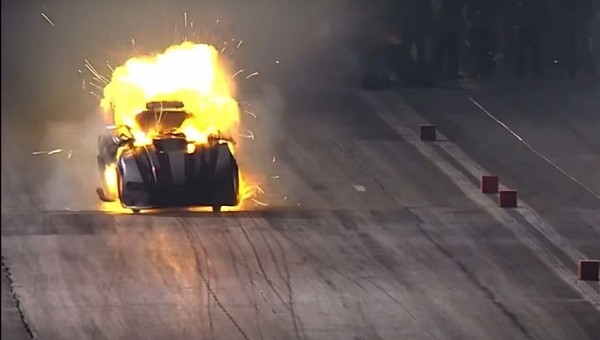There is no clear reason why they are called funny cars, but maybe it is the fact that their fiberglass or carbon fiber tilt-up bodies appear to be caricatures of newly available cars.
But there is nothing comical about these impressive race cars. Packed with V8 engines no more than 500 cubic inches (8.2 liters) in size and loosely based on the second generation Chrysler 426 Hemi, these cars now perform on a level equal to that of the big daddy of drag racing-Top Fuel dragsters.
These supercharged two-valve engines can burn as much as 15 gallons (57 liters) of a mixture of 85-90% nitromethane and 10-15% of methanol fuel over the course of a single run that includes starting, burn out, backing up, staging, and the 1,000-foot (304.8 meters) race itself.
The engines produce between 10,000 and 11,000 horsepower and generate 7,000 ft-lb (9,500Nm) of torque subjecting drivers to a force six times their body weight at the start of a race.
With regard to acceleration from the start, they lag just behind Top Fuel dragsters with one critical difference. Funny Car engines packing all of their power sit right in front of the driver as opposed to dragsters whose drivers are positioned in front of the engine.
Regardless of all the safety features implemented in Top Fuel and Funny Car since Scott Kalitta was killed in 2008 including reducing the length of the race from a true ¼ mile (.4 km) to 1000 feet (304.8 meters), any engine mishap can be frightening.
Matt Hagan is no stranger to engine explosions and it just so happens that he incurred one at a critical juncture in his pursuit of a championship at Pomona during the Auto Club NHRA Finals. Matched up against drag racing legend John Force and starting from the right lane, Hagan eclipsed 245 mph (394 kp/h) when his engine exploded in a ball of flames.
Hagan was able to deploy the parachutes to eventually bring his burning car to a halt and bail out of the rooftop escape hatch unhurt; though his chances of a championship may have exploded as well.
These supercharged two-valve engines can burn as much as 15 gallons (57 liters) of a mixture of 85-90% nitromethane and 10-15% of methanol fuel over the course of a single run that includes starting, burn out, backing up, staging, and the 1,000-foot (304.8 meters) race itself.
The engines produce between 10,000 and 11,000 horsepower and generate 7,000 ft-lb (9,500Nm) of torque subjecting drivers to a force six times their body weight at the start of a race.
With regard to acceleration from the start, they lag just behind Top Fuel dragsters with one critical difference. Funny Car engines packing all of their power sit right in front of the driver as opposed to dragsters whose drivers are positioned in front of the engine.
Regardless of all the safety features implemented in Top Fuel and Funny Car since Scott Kalitta was killed in 2008 including reducing the length of the race from a true ¼ mile (.4 km) to 1000 feet (304.8 meters), any engine mishap can be frightening.
Matt Hagan is no stranger to engine explosions and it just so happens that he incurred one at a critical juncture in his pursuit of a championship at Pomona during the Auto Club NHRA Finals. Matched up against drag racing legend John Force and starting from the right lane, Hagan eclipsed 245 mph (394 kp/h) when his engine exploded in a ball of flames.
Hagan was able to deploy the parachutes to eventually bring his burning car to a halt and bail out of the rooftop escape hatch unhurt; though his chances of a championship may have exploded as well.







